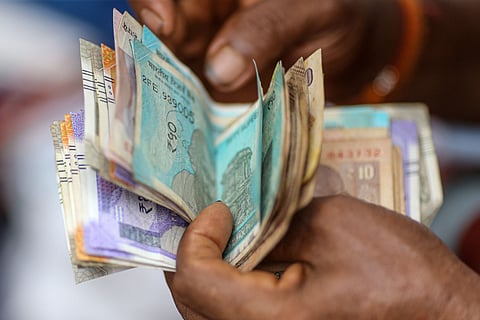Indian rupee to stay below 23.5 vs UAE dirham for now: Do NRIs wait to remit?
Rupee up 1.2% in 2 weeks, India's Bank of Baroda sees 85.3–86.3 vs. US dollar in near-term

Dubai: The Indian rupee has bounced back smartly over the past two weeks — rising 1.2% and currently trading around 23.28 against the UAE dirham, after having dipped to 23.5 levels in mid-June.
This recovery has prompted many Indian expats in the UAE to hold off on making transfers, in hopes the currency might fall again — ideally to 23.4 or better — before they send money home. (Check the latest Indian rupee exchange rate here.)
That hesitation might not last long. According to the Bank of Baroda’s latest forex outlook, the rupee is likely to trade in a narrow range of 85.25 to 86.25 versus the US dollar, which equates to roughly 23.26 to 23.54 against the dirham in the near term.
In short: if you’re waiting for a major dip, that window could be narrow.
India-US trade deal may support rupee
The report suggests that an anticipated India-US trade agreement could help keep the rupee supported — making a sharp dip less likely. “We expect INR to trade in the range of 85.25–86.25/USD. A trade deal between India and the US will be positive for the rupee,” the bank said.
The expectation of continued weakness in the US dollar due to stagflation risks, a pause in interest rate hikes, and growing political uncertainty are also likely to support the rupee. Domestically, India’s strong macro fundamentals and ample foreign exchange reserves should further prevent any steep depreciation.
How UAE NRIs can plan remittances
Remittances typically spike in June and July, when Indian families abroad plan summer travel or increase household spending. But this year’s rupee recovery may nudge senders to wait for better rates — even a few paise can make a difference on large transfers.
While the interbank rate hovers around 23.28, currency apps and banks in the UAE have been offering special promotions — with rates like 23.4, 23.39, and even 23.38 available briefly last week, beating the official rate of 23.34 at the time. Such offers tend to be time-limited, but they show that opportunistic timing can help maximise returns.
What could move the rupee next?
While the broader range looks capped for now, a few factors could create short-term movement:
July 9 is the next key date to watch, as the US tariff pause deadline could affect sentiment and add temporary volatility.
A renewed easing in Middle East tensions, which previously helped reduce oil prices in June, may also give the rupee a breather.
Continued foreign equity inflows into India are another tailwind.
Despite a 0.2% dip in June (after a 1.3% fall in May), the rupee ended June stronger — recovering 0.4% in the last fortnight alone. Much of this rebound was due to improved global risk appetite and a weaker dollar, triggered by poor US consumer spending data and concerns around the Federal Reserve’s independence.
Bottom line: Is 23.5 possible again?
If you're an NRI in the UAE looking for a sweet spot to send money to India, watch for temporary offers and short-term dips — the range of 23.25 to 23.54 seems to be where the rupee will stay for now.
But given the positive macro signals and global dollar softness, a big drop below 23.4 may be limited unless a new shock disrupts sentiment. As always, timing your remittance around market dips or flash promotions could offer the best value.
Sign up for the Daily Briefing
Get the latest news and updates straight to your inbox




